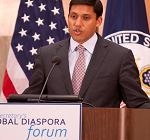Over the last decade, both Democrat and Republican parties have tried to capture the loyalty of the approximately 2.1 million Indian-American voters in the U.S. Traditionally, they have been Democrat; but the U.S.-India Civil Nuclear Deal, pushed to law by Indian-American effort, and which brought India out of international energy isolation, made Indian-American voters lean Republican.
But a recent study[1] by Lake Research Partners, a political strategy research firm, says that 84% of Indian-Americans voted Democrat in the 2008 U.S. presidential election.
The study also suggests that 85% of them favour U.S. President Barack Obama, the Democratic incumbent, for re-election in 2012. This, despite the strides Republicans have made to embrace U.S.-India relations over the last decade, and despite Obama’s election year attacks on outsourcing.
A closer look will explain the seemingly-anomalous voting preference. Indian-American voters are increasingly prioritising their local concerns over the larger U.S.-India bilateral relationship. At the core of their expectations is a liberal-leaning social policy that allows for greater inclusion in American society, politics, and business.
In this context, the Democrats are doing better, primarily for two reasons. U.S. President Barack Obama has included and engaged more Indian-Americans—around 17—in his government than any of his predecessors. (The Bush administration had five Indian-Americans and Bill Clinton had none.) Democrats also respond to demands for political and social inclusion in a way that appeals to Indian-Americans. In addition, second generation Indian-Americans tend to be more liberal. For instance, they favour Obama’s handling of the economy, are more accepting of homosexuals, and are more pro-choice than not. This 18-34 age group comprises almost 1.4 million people.[2]
The Indian-Americans in the Obama administration have made significant strides in their positions. For example, Rajiv Shah, a second generation Indian-American from Michigan was appointed chief of USAID by Obama in 2009. He initiated USAID Forward, a new reform agenda that emphasises innovation and better management processes. Sri Srinavasan, an Indian-American lawyer born in India and raised in Kansas, was appointed the country’s Principal Deputy Solicitor General in June 2012. His job includes determining the U.S. government’s position on the cases it argues in the Supreme Court. There is also Preet Bharara, US attorney for the southern district of New York, famous now for the conviction of another Indian-American, Rajat Gupta.
The U.S. State Department also created a new position to cultivate a relationship between Washington and the émigrés of different nations. An Indian-American finance expert, Mitul Desai, was appointed as Senior Advisor to the State Department to facilitate this relationship-building. In just a year, Desai has helped launch an online portal to help Indian-Americans safely donate funds to NGOs in India; he has also fostered collaborations between the South Asian diaspora and partners in South Asia.[3] Desai’s appointment expands India-U.S. ties in a way that previous pro-India Republican administrations did not think of.
The changing demography of Indian-Americans is helping the Democrats. According to the 2010 U.S. Census, the majority of the immigrants arriving in the late 1980s settled in California and New York, blue states where the information technology and financial services industries are located. Most Indian-Americans are still based in the Bay Area, Los Angeles and New York; the children of these immigrants have grown up in a political atmosphere that supports liberal policies. They can identify with Obama, and when they reached voting age in 2008, this generation voted for him.
Will Obama or his successor continue to engage Indian-Americans in the next Presidential term? The outsourcing of jobs to India is a contentious issue in this re-election this year, and it may dampen the Obama administration’s pro-India moves. But the political and financial clout and aspirations of the Indian-American community are growing, and both Democrats and Republicans will surely engage this vote bank.
There is the practical issue of funding – and Indians in general are better educated and more affluent than most other immigrant communities in the U.S. According to the Pew survey, almost 1.7 million Indian-Americans have a four-year-degree and the median household income is $88,000 – almost double the national average. Wooing this group is financially lucrative. Estimates by the U.S.-India Political Action Committee show that Indian-Americans contributed $20 million in campaign funds to both parties in 2008. A report by Washington D.C.’s Centre for Responsive Politics says that just seven Indian-Americans have collectively raised $850,000 for Obama so far this year alone.[4]
The Democrats are likely to continue to reap the rewards of their political calculations. Unless the Republicans do more to engage Indian-American voters, they will largely be leaning Democrat come November.
Advait Praturi is the diaspora liaison at Gateway House: Indian Council on Global Relations.
This article was exclusively written for Gateway House: Indian Council on Global Relations. You can read more exclusive content here.
For interview requests with the author, or for permission to republish, please contact outreach@gatewayhouse.in.
© Copyright 2012 Gateway House: Indian Council on Global Relations. All rights reserved. Any unauthorized copying or reproduction is strictly prohibited


